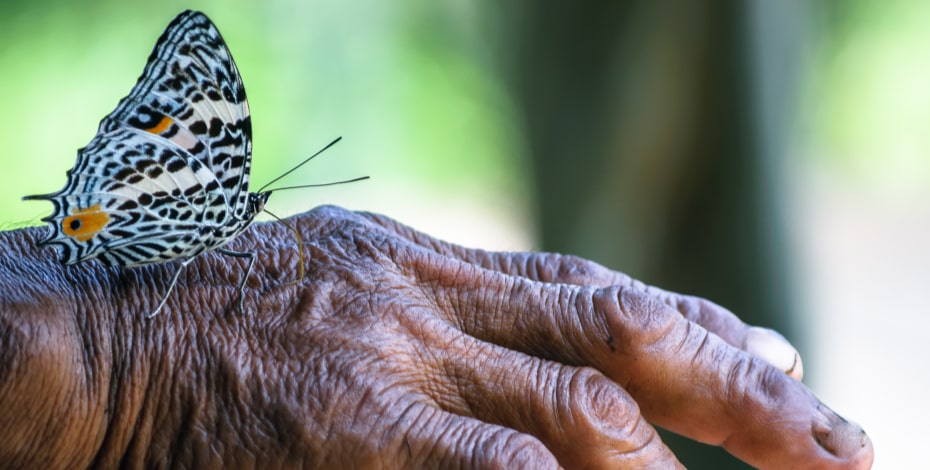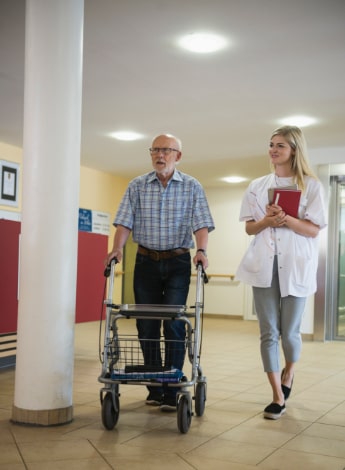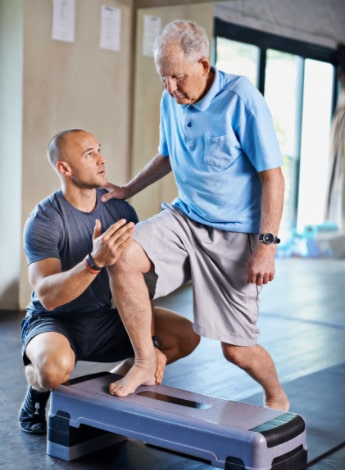
Five facts about … frailty

APA Gerontology group Western Australia Chair Kate Ellis, with contributions from the national group committee and Tony Petta, presents five discussion points about the role physiotherapists can play in healthy ageing and the prevention of frailty.
1. Frailty is common but not inevitable
Frailty is a syndrome characterised by a decrease in physiological reserve and increase in susceptibility to illness, hospitalisation, disability and mortality.
There are many different ways to define and assess frailty and therefore prevalence varies greatly.
Internationally, studies using the Fried Frailty Phenotype showed overall frailty at 10–14 per cent and 26 per cent in the 85-plus age group (Collard et al 2012, Shamliyan et al 2013), while studies using the Accumulation of Deficits approach showed overall frailty at 24 per cent and 50–56 per cent in the 85-plus age group (Shamliyan et al 2013).
In the Australian population pooled data, overall frailty sits at 21 per cent and pre-frailty at 48 per cent (Thompson et al 2018).
Remote-living Aboriginal people are more likely to become frail than in the non-Aboriginal population (Hyde et al 2016) with overall frailty in those 45 years and over at 67.6 per cent and in people aged over 80 years at 83.3 per cent.
Most reports likely underestimate frailty in the total and prevalence is expected to rise in line with our ageing population (Hoogendijk et al 2019).
Although frailty is common, it is important to understand that it is not a normal part of ageing and that people who live with frailty are capable of reversing the effects (Gill et al 2006).
2. Frailty screening and assessment is important in older people
Not all older people are frail; however, it is important that all older people are screened for frailty.
Early identification is key to management of the condition and can help to reduce adverse effects and improve outcomes (British Geriatrics Society 2017).
Physiotherapists are well positioned to initiate a frailty screen and participate in a full assessment.

There are two main approaches to identifying frailty in research and practice: The Fried Frailty Phenotype and the Accumulation of Deficits Model (Fried et al 2001, Rockwood et al 2005).
The five typical clinical signs of frailty that warrant further investigation are falls, reduced mobility, delirium, incontinence and susceptibility to medication side-effects (British Geriatrics Society 2017).
If any of these signs are observed, it is recommended to complete a frailty screen. Because there is no clear definition for frailty, there is also no one definitive way to screen for it.
There are functional tools that physiotherapists can use as a quick screen including gait speed, four metre and 10 metre walk tests, Timed Up and Go and grip strength.
After a frailty screen, best practice then recommends referring clients for a full multidisciplinary geriatric assessment (British Geriatrics Society 2017) that should include assessment of physical, functional, mobility and balance, psychological, environmental, social and medication domains.
3. People with frailty are at risk of falls and fractures related to falls
Falls are common in the older population and frailty further increases that risk, with prevalence reported between 6.7 and 44 per cent (Fhon et al 2016).
People living with frailty also have a higher risk of fall-related fractures, subsequent hospitalisation and institutionalisation (Joseph et al 2015).
This can have a significant negative impact on the person, their family and the healthcare system.
Increasing age, polypharmacy, reduced level of physical activity, cognitive changes, incontinence, presence of comorbidities, impaired vision/hearing, sarcopenia and osteoporosis are aspects of frailty that can lead to falls and frailty-related fractures.
Falls prevention is critical in the frail older population. Management strategies should mirror those outlined for the general older population and include an ongoing multicomponent exercise program with a high balance challenge and sufficient dose (Sherrington et al 2017).
In those with particular risk factors, it is important to consider non exercise-based adjunct interventions, such as home environment modification and referral to multidisciplinary specialties (Gillespie et al 2009, Sherrington et al 2017).
Building bone strength helps in the prevention of fractures. Best practice recommends a combination of weight- bearing and resistance exercises alongside lifestyle changes and pharmacological management.
There is little evidence that people with osteoporosis are at risk of fragility fractures related to exercise (National Osteoporosis Society 2019).
4. Physiotherapists play an important role in prevention of frailty and promoting healthy ageing across the lifespan
Frailty has widespread consequences for the older person, their carers, the community and the healthcare system. Interventions that prevent or reduce the severity of frailty are critical to managing the impact of this growing global health concern (Dent et al 2019, Hajek et al 2018).
Early identification and intervention for frailty allows people to stay active, healthy, independent and to avoid unnecessary harm (British Geriatrics Society 2017).

Management strategies should target specific identified deficits such as falls, mobility, physical inactivity, polypharmacy, lifestyle factors (eg, drinking, smoking and weight), social isolation, cognitive changes, psychological factors, continence issues, unstable health conditions, service or system issues, reduced participation in daily tasks and impaired vision/hearing (British Geriatrics Society 2017, Fairhall et al 2011).
Physiotherapists have a direct impact on many of these deficits and can address other concerns by making appropriate referrals to the wider multidisciplinary team.
Regular re-assessments must also be conducted to ensure changes in function are identified (Fairhall et al 2011) to prevent further escalation of frailty.
Physiotherapy can be active across a person’s lifespan as well as across specialties. This puts our profession in the perfect position to identify those at risk of frailty, assist to prevent onset, reduce severity of established frailty and promote healthy ageing at all stages of life.
5. Physical activity is safe and effective in prevention and treatment of frailty
Exercise has been shown to improve cardiorespiratory function, muscle function, flexibility and functional ability in frail older people (Theou et al 2011).
Multicomponent progressive exercise programs with protein supplementation have shown to produce the best outcomes and are easiest to implement (Theou et al 2011, Travers et al 2019).
However, there is significant variation in the literature regarding specific exercise dosage (Dent et al 2019).
Overall guidelines for exercise are inclusion of resistance, aerobic, flexibility, balance/coordination with an emphasis on strength and balance training; functional exercises as able; an individually tailored program related to client goals; greater than 5–6 month duration, 2–3 times a week and 45–60 minutes in total (30–45 minutes in moderate to severe frailty) (Bray et al 2016, Theou et al 2011).
There are no specific contraindications to a frail older person exercising, with very few adverse events documented in the literature.
However, it is recommended to use the same precautions as the general older population and start at a lower intensity to avoid risk of injury (Theou et al 2011).
Compliance is often low in the older frail population (Fairhall et al 2017) and therefore measures to improve long-term adherence to an exercise program must also be considered.
This should include addressing individual health concerns, targeted exercises, self-monitoring and appropriate goal-setting (Fairhall et al 2011).
>>
- References
Bray, N., Smart, R.R., Jakobi, J.M., & Jones, G.R. (2016). Exercise prescription to reverse frailty. Appl Physiol Nutr Metab, 41(10):1112-1116
British Geriatrics Society (2017). Fit for frailty: Consensus best practice guidance for the care of older people living with frailty in community and outpatient settings. British Geriatrics Society: Technical Report. London: British Geriatrics Society
Collard, R.M., Boter, H., Schoevers, R.A., &. Oude Voshaar, R.C. (2012).Prevalence of frailty in community-dwelling older persons: A systematic review. Journal of the American Geriatrics Society, 60, 1487–1492.
Dent, E., Martin, F.C., Bergman, H., Woo, J., Romero-Ortuno, R., & Walston, J.D. (2019). Management of frailty: opportunities, challenges, and future directions. Lancet, 394, 1376–86.
Fairhall, N., Langron, C., Sherrington, C. et al. Treating frailty-a practical guide. BMC Med 9, 83 (2011). https://doi.org/10.1186/1741-7015-9-83
Fairhall, N., Sherrington, C., Cameron, I., Kurrle, S., Lord, S., Lockwood, K., & Herbert, R. (2017). A multifactorial intervention for frail older people is more than twice as effective among those who are compliant: complier average causal effect analysis of a randomised trial. Journal of Physiotherapy, 63, 40-44.
Fhon, J. R., Rodrigues, R. A., Neira, W. F., Huayta, V. M., & Robazzi, M.L. (2016). Fall and its association with the frailty syndrome in the elderly: systematic review with meta-analysis. Rev Esc Enfern USP, 50, 1005-1013.
Fried, L.P., Tangen, C.M., Walston, J., et al. (2011). Frailty in older adults: Evidence for a phenotype. Journals of Gerontology. Series A. Biological Sciences and Medical Sciences, 56, M146–M156.
Gill, T.M., Gahbauer, E.A., Allore, H.G., & Han, L. (2006). Transitions between frailty states among community-living older persons. Archives of Internal Medicine, 2006, 166, 418–423.
Gillespie. L.D., Robertson, M.C., Gillespie, W.J., Lamb, S.E., Gates, S., Cumming, R.G., & Rowe, B.H. (2009). Interventions for preventing falls in older people living in the community. Cochrane Database Syst Rev, CD007146.
Hajek. A., Bock. J., Saum, K., Matschinger, H., Brenner, H., Holleczek, B., Haefel. W., Heider, D., & Konig, H. (2018). Frailty and healthcare costs—longitudinal results of a prospective cohort study. Age and Ageing, 47, 233–241
Hoogendijk. E., Afilalo, J., Ensrud, K., Kowal, P., Onder, G., & Fried, L. (2019). Frailty: implications for clinical practice and public health. Lancet, 394, 1365–75.
Hyde, Z., Flicker. L., Smith, K., Atkinson, D., Fenner, S., Skeaf. L., Malay. R., & Lo Guidice, D. (2016). Prevalence and incidence of frailty in Aboriginal Australians, and associations with mortality and disability. Maturitas, 87, 89–94.
Joseph, B., Pandit, V., Khalil, M., Kulvatunyoi, N., Zangbar, B., Friese, R. S., Mohler, M. J., Fain, M. J., & Rhee, P. (2015). Managing older adults with ground-level falls admitted to a trauma service: the effect of frailty. J Am Geriatr Soc., 63(4), 745-9.
National Osteoporosis Society (2019). Strong, Steady & Straight: NOS Exercise and Osteoporosis Consensus Statement. https://www.bgs.org.uk/resources/strong-steady-straight-nos-exercise-and... [Retrieved 16/02/2021]
Rockwood. K., Song, X., MacKnight, C., Bergman, H., Hogan, D.B., McDowell, I., & Mitnitski, A. (2005). A global clinical measure of fitness and frailty in elderly people. CMAJ. Aug 30, 173(5), 489–495
Shamliyan, T., Talley, K.M., Ramakrishnan, R., & Kane, R.L. (2013). Association of frailty with survival: A systematic literature review. Ageing Research Review, 12, 719–736.
Sherrington, C., Michaleff, Z.A., Fairhall, N., Paul, S.S., Tiedemann, A., Whitney, J., Cumming, R.G., Herbert, R.D., Close, J.C.T., & Lord, S.R. (2017). Exercise to prevent falls in older adults: an updated systematic review and meta-analysis. Br J Sports Med, 51, 1749–1757.
Theou, I., Stathokostas, L., Roland. K.P., Jakobi, J.M., Patterson, C., VanderVoort, A.A., & Jones, G.R. (2011). The Effectiveness of Exercise Interventions for the Management of Frailty: Systematic Review. J Ageing Res. 2011, Article ID 569194.
Thompson, M., Theou, O., Karnan, J., Adams, R., & Visvanathan, R. (2018).Brief Report Frailty prevalence in Australia: Findings from four pooled Australian cohort studies. Australasian Journal on Ageing, 37 (2), 155–158
Travers, J., Romero-Ortuno, R., Bailey, J., & Cooney, M. (2019). Delaying and reversing frailty: a systematic review of primary care interventions. British Journal of General Practice, 69 (678): e61-e69. DOI: https://doi.org/10.3399/bjgp18X700241
Click here for an infographic poster version of this article.
Kate Ellis, APAM, has more than 10 years’ experience in aged care. Kate works as a care manager and physiotherapist at Silver Chain in Western Australia. She is Chair of the APA Gerontology Committee in Western Australia and the state representative on the APA Gerontology National Committee.
© Copyright 2025 by Australian Physiotherapy Association. All rights reserved.





